
Trilobites are extinct marine arthropods that form the class Trilobita. Trilobites form one of the earliest known groups of arthropods. The first appearance of trilobites in the fossil record defines the base of the Atdabanian stage of the Early Cambrian period and they flourished throughout the lower Paleozoic before slipping into a long decline, when, during the Devonian, all trilobite orders except the Proetida died out. The last trilobites disappeared in the mass extinction at the end of the Permian about 251.9 million years ago. Trilobites were among the most successful of all early animals, existing in oceans for almost 270 million years, with over 22,000 species having been described.
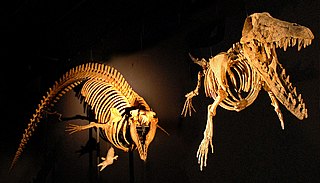
Archaeoceti, or Zeuglodontes in older literature, is a paraphyletic group of primitive cetaceans that lived from the Early Eocene to the late Oligocene. Representing the earliest cetacean radiation, they include the initial amphibious stages in cetacean evolution, thus are the ancestors of both modern cetacean suborders, Mysticeti and Odontoceti. This initial diversification occurred in the shallow waters that separated India and Asia 53 to 45 mya, resulting in some 30 species adapted to a fully oceanic life. Echolocation and filter-feeding evolved during a second radiation 36 to 35 mya.
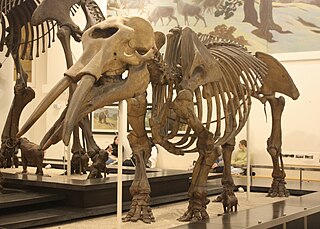
Gomphotherium is an extinct genus of gomphothere proboscidean from the Neogene of Eurasia, Africa and North America. It is the most diverse genus of gompothere, with over a dozen valid species. The genus is probably paraphyletic.
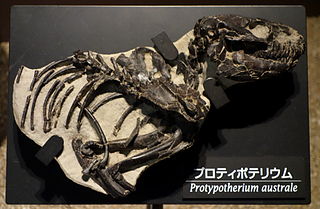
Protypotherium is an extinct genus of notoungulate mammals native to South America during the Oligocene and Miocene epochs. A number of closely related animals date back further, to the Eocene. Fossils of Protypotherium have been found in the Deseadan Fray Bentos Formation of Uruguay, Muyu Huasi and Nazareno Formations of Bolivia, Cura-Mallín and Río Frías Formations of Chile, and Santa Cruz, Salicas, Ituzaingó, Aisol, Cerro Azul, Cerro Bandera, Cerro Boleadoras, Chichinales, Sarmiento and Collón Curá Formations of Argentina.

Cramauchenia is an extinct genus of litoptern South American ungulate. Cramauchenia was named by Florentino Ameghino. The name has no literal translation. Instead, it is an anagram of the name of a related genus Macrauchenia. This genus was initially discovered in the Sarmiento Formation in the Chubut Province, in Argentina, and later it was found in the Chichinales Formation in the Río Negro Province and the Cerro Bandera Formation in Neuquén, also in Argentina, in sediments assigned to the SALMA Colhuehuapian, as well as the Agua de la Piedra Formation in Mendoza, in sediments dated to the Deseadan. In 1981 Soria made C. insolita a junior synonym of C. normalis. A specimen of C. normalis was described in 2010 from Cabeza Blanca in the Sarmiento Formation, in sediments assigned to the Deseadan SALMA.
Paleontology or palaeontology is the study of prehistoric life forms on Earth through the examination of plant and animal fossils. This includes the study of body fossils, tracks (ichnites), burrows, cast-off parts, fossilised feces (coprolites), palynomorphs and chemical residues. Because humans have encountered fossils for millennia, paleontology has a long history both before and after becoming formalized as a science. This article records significant discoveries and events related to paleontology that occurred or were published in the year 2000.

The Oncocerida comprise a diverse group of generally small nautiloid cephalopods known from the Middle Ordovician to the Mississippian, in which the connecting rings are thin and siphuncle segments are variably expanded. At present the order consists of some 16 families, a few of which, such as the Oncoceratidae, Brevicoceratidae, and Acleistoceratidae contain a fair number of genera each while others like the Trimeroceratidae and Archiacoceratidae are represented by only two or three.
Lissoceras is an involute, smooth or finely vetrolaterally ribbed, ammonite with a blunt, un-keeled venter, included in the Haploceratidae, that lived from the Lower Bajocian - Middle Oxfordian in what is now Europe, south Asia, and southern Alaska.

Ptychoceratodus is an extinct genus of lungfish living from Early Triassic to Middle Jurassic. It was established by Otto Jaekel for one species, transferred from Ceratodus genus. Type species is P. serratus from the Middle Triassic of Switzerland and Germany. Ptychoceratodus had two pairs of massive dental plates, bearing 4-6 acute ridges. Its skull roof was composed from massive, plate-like bones. In the central part of skull roof was localized an unossified fenestra. Most of the Ptychoceratodus findings are isolated dental plates, some associated with jaws. Other parts of skull or postcranial skeleton are relatively rarely found as fossils. The anatomy of skull is the best recognized in P. serratus, whereas less complete cranial material is available also for P. concinuus, P. phillipsi, and P. rectangulus. Although Ptychoceratodus is known exclusively from the Triassic and Jurassic, there were also Cretaceous specimens referred to this genus. However, they are more often regarded as representants of Metaceratodus. Ptychoceratodus is the only member of the family Ptychoceratodontidae. The first named species is P. phillipsi by Louis Agassiz in 1837 as a species of Ceratodus and later moved to the genus Ptychoceratodus. Occurrences of Ptychoceratodus come mainly from Europe. However, occurrences from other continents suggest it was dispersed globally during the Triassic. After 2010, the new fossil material behind the Europe was reported from South America, India, and Greenland
Cerrejonemys wayuunaiki is an extinct podocnemid turtle which existed in Colombia during the Paleogene period; the Middle to Late Paleocene epoch.
Trilobites are used as index fossils to subdivide the Cambrian period. Assemblages of trilobites define trilobite zones. The Olenellus-zone has traditionally marked the top of the Lower Cambrian, and is followed by the Eokochaspis zone.

Paleontology in Iowa refers to paleontological research occurring within or conducted by people from the U.S. state of Iowa. The paleozoic fossil record of Iowa spans from the Cambrian to Mississippian. During the early Paleozoic Iowa was covered by a shallow sea that would later be home to creatures like brachiopods, bryozoans, cephalopods, corals, fishes, and trilobites. Later in the Paleozoic, this sea left the state, but a new one covered Iowa during the early Mesozoic. As this sea began to withdraw a new subtropical coastal plain environment which was home to duck-billed dinosaurs spread across the state. Later this plain was submerged by the rise of the Western Interior Seaway, where plesiosaurs lived. The early Cenozoic is missing from the local rock record, but during the Ice Age evidence indicates that glaciers entered the state, which was home to mammoths and mastodons.

Paleontology in Oklahoma refers to paleontological research occurring within or conducted by people from the U.S. state of Oklahoma. Oklahoma has a rich fossil record spanning all three eras of the Phanerozoic Eon. Oklahoma is the best source of Pennsylvanian fossils in the United States due to having an exceptionally complete geologic record of the epoch. From the Cambrian to the Devonian, all of Oklahoma was covered by a sea that would come to be home to creatures like brachiopods, bryozoans, graptolites and trilobites. During the Carboniferous, an expanse of coastal deltaic swamps formed in areas of the state where early tetrapods would leave behind footprints that would later fossilize. The sea withdrew altogether during the Permian period. Oklahoma was home a variety of insects as well as early amphibians and reptiles. Oklahoma stayed dry for most of the Mesozoic. During the Late Triassic, carnivorous dinosaurs left behind footprints that would later fossilize. During the Cretaceous, however, the state was mostly covered by the Western Interior Seaway, which was home to huge ammonites and other marine invertebrates. During the Cenozoic, Oklahoma became home to creatures like bison, camels, creodonts, and horses. During the Ice Age, the state was home to mammoths and mastodons. Local Native Americans are known to have used fossils for medicinal purposes. The Jurassic dinosaur Saurophaganax maximus is the Oklahoma state fossil.
Xenocretosuchus is an extinct genus of tritylodont therapsids from the Aptian Ilek Formation of Siberia, in the Russian Federation. The type species, X. sibiricus, is known only from dental elements, as is X. kolossovi, described from the Batylykh Formation in 2008. Some authors have treated these species as part of the genus Stereognathus, otherwise known from the Middle Jurassic of Britain, but this is rejected by other authors.
Titanogomphodon is an extinct genus of diademodontid cynodonts from the Middle Triassic Omingonde Formation of Namibia. It is known from a single partial skull that was described in 1973 from the Omingonde Formation. The type and only species is Titanogomphodon crassus. At about 40 centimetres (16 in), the skull of Titanogomphodon was significantly larger than that of its closest relative, Diademodon. Its teeth are similar to those of another group of cynodonts called Traversodontidae, but the similarities are likely the result of convergent evolution. Aside from its larger size, Titanogomphodon differs from Diademodon in having a bony projection on the postorbital bar behind the eye socket.

Asterolepis is an extinct genus of antiarch placoderms from the Devonian of North and South America and Europe. They were heavily armored flat-headed benthic detritivores with distinctive jointed limb-like pectoral fins and hollow spine. The armor plate gives the Asterolepis a box-like shape. Its pectoral fins are also armored but the caudal and dorsal fin are not. The first fossils were named by M. Eichwald in 1840 after noticing star-like markings on the fossils.
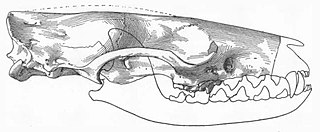
Viverravus is an extinct genus of placental mammals from extinct subfamily Viverravinae within extinct family Viverravidae, that lived in North America, Europe and Asia from the middle Paleocene to middle Eocene.
Shingopana is a genus of titanosaurian sauropod from the Upper Cretaceous Galula Formation of Tanzania. It is known from only the type species, S. songwensis. Gorscak & O'Connor's phylogenetic testing suggest Shingopana is more closely related to the South American titanosaur family of Aeolosaurini than any of the titanosaurs found so far in North & South Africa.

Kutorginates (Kutorginata) are an extinct class of early rhynchonelliform ("articulate") brachiopods. The class contains only a single order, Kutorginida (kutorginides). Kutorginides were among the earliest rhynchonelliforms, restricted to the lower-middle part of the Cambrian Period.
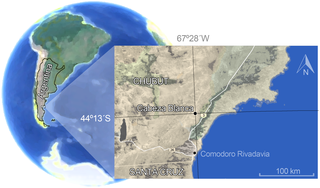
The Sarmiento Formation, in older literature described as the Casamayor Formation, is a geological formation in Chubut Province, Argentina, in central Patagonia, which spans around 30 million years from the mid-Eocene to the early Miocene. It predominantly consists of pyroclastic deposits, which were deposited in a semi-arid environment. It is divided up into a number of members. The diverse fauna of the Sarmiento Formation, including a variety of birds, crocodilians, turtles and snakes, also includes many mammals such as South American native ungulates as well as armadillos, and caviomorph rodents.












